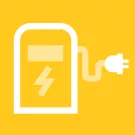Drivers in Greater Minnesota tend to travel longer distances.
If you're traveling in an EV, those longer distances provide more opportunities to save on fuel costs and maintenance. Even though the up-front cost of an EV can be higher than a gas- or diesel-powered vehicle, EVs offer significant savings on fuel and maintenance costs — about four cents/mile. This results in a lower lifetime cost of ownership of an EV, on average $8,000. The more miles an EV is driven, the more savings on fuel and maintenance.
EV charging access in Greater Minnesota is improving every day due to federal, state, utility, and other investments.
The State of Minnesota is focused on building out transportation corridors with an emphasis on rural and underserved communities. Utility, business, city, and community investments and actions will make Minnesota’s charging network even more robust. Find available chargers through PlugShare and Alternative Fuels Data Center.
Plus, over 80% of EV charging happens overnight at home.
A standard 120-volt outlet will provide 2-5 miles of range per hour of charging. A 240-volt outlet (like the outlet that powers an electric clothes dryer) can charge an EV even faster. Some electric utilities offer a special off-peak charging rate, which makes home charging even cheaper.
For winter driving EVs offer benefits and in some cases, challenges, so it's important to understand your driving habits.
With more consistent acceleration and a lower center of gravity, electric vehicles often perform better in cold weather than gasoline vehicles.
Another consideration is that for long trips in the winter, reduced range can be a concern: -10 F and below can reduce range by up to 40%. If you make frequent long trips during the winter months, a plug-in hybrid is likely to be a good fit for you, while all-electric is likely to be a better fit if most of your driving is shorter trips or if your household has a second vehicle better suited to long winter drives.

